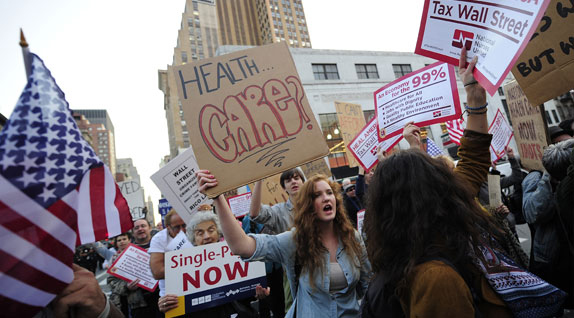 Emmanuel Dunand/AFP/Getty Images
Emmanuel Dunand/AFP/Getty Images
Article
Economic uncertainty has inspired thousands of protesters globally to take a stance against capitalism. Their alternative is yet to be defined.
Learn the why behind the headlines.
Subscribe to the Real Truth for FREE news and analysis.
Subscribe NowThe signs say it all. “Housing is a human right.” “Capitalism is a kind of slavery with fake golden chains.” “The London Stock Exchange: Britain’s Biggest Casino Since 1801.” “Turn Wall Street into Tahrir Square.” “Eat the Rich.”
Protesters are angry. They want change. And they want it now.
Given headlines—“14 Million Jobless,” “Unemployment Adds 9 Million Uninsured” and “One Out of Every 15 People Lives in Extreme Poverty”—their frustration seems warranted.
Since the Occupy Wall Street (OWS) movement first encamped in New York City’s financial district in mid-September, the group has gained worldwide traction.
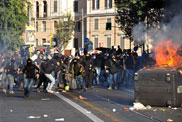 Alberto Pizzoli/AFP/Getty Images
Alberto Pizzoli/AFP/Getty Images
“From Seattle to Sydney, protesters have taken to the streets,” The Economist reported. “Whether they are inspired by the Occupy Wall Street movement in New York or by the indignados in Madrid, they burn with dissatisfaction about the state of the economy, about the unfair way that the poor are paying for the sins of rich bankers, and in some cases about capitalism itself.”
The movement, a copy of Egypt’s and Tunisia’s uprisings, maintains it is dedicated to the “power of the people.” It considers itself a “leaderless democracy,” stating on its website, “Decisions are made democratically, without voting, by general assent.”
Yet it claims to uphold what they call a fundamental principle of anarchism: “…that in the same way human beings treated like children will tend to act like children, the way to encourage human beings to act like mature and responsible adults is to treat them as if they already are.”
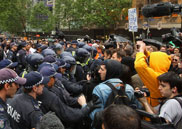 Mark Dadswell/Getty Images
Mark Dadswell/Getty Images
While some consider it a big party, advocates are optimistic its ideals about “world revolution” will spread globally. What exactly those ideals are, however, has yet to be determined, as another Economist article noted.
“The protests that have mushroomed in over 900 cities in 80-plus countries over the past few days have voiced few practical demands, and in some cases they actually avoid making any. Participants favour the general over the specific. They think need matters more than greed. They like decisions by consensus, distrust elites and feel that capitalism’s pains and gains are unfairly shared. Beyond that, the horizon clouds.”
Yet one thing is certain. Supporters of OWS are angry, disillusioned and desire a solution that can provide the results they demand. And, it appears, they will not stop until they find one.
Opposite Sides
Occupy protests are complex, with many interacting players. There are Wall Street businessmen, Washington politicians, unemployed, police attempting to keep peace, idealistic university students, stay-at-home mothers, those drowning in debt, and those indifferent to the whole cause. Each side has its own story.
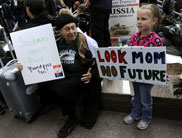 Timothy A. Clary/AFP/Getty Images
Timothy A. Clary/AFP/Getty Images
For the most part, protesters—who call themselves the “99 percent”—are against “corporate greed” and the “1 percent” of Americans who they claim hold almost 50 percent of wealth. Bankers are often painted as money-grubbing, private-jet-hopping, uncaring businessmen who do nothing but laugh about their millions while playing golf.
Demonstrators in the United States, for example, complain that big corporations fund politicians, which works to hurt, not serve, the electorate. After being elected, the argument goes, these same politicians then cater to the companies who funded them and neglect those who cast ballots for them.
Others feel frustrated by the rich-poor gap. They ask why over 20 percent of new college graduates are unemployed and buried in student-loan debt. They question the need for the high cost of national defense given that about 16 percent of Americans live below the poverty line.
 Justin Sullivan/Getty Images
Justin Sullivan/Getty Images
In Europe, protesters are angry that tax money has bailed out big banks, yet CEOs received big bonuses, all while their countries face austerity measures.
“Spain, like Greece and Italy, faces huge public deficits,” The Christian Science Monitor reported. “The government has been cutting outlays for basic services like schools, health care, and social welfare. While college attendance in Spain is a success story, youth unemployment has risen to a horrific 44 percent.”
Because of its Robin-Hoodesque message, “Take more from the rich!” increasing numbers seek safety in OWS’s ranks.
“We are all living in dire times,” one of the movement’s key architects told Forbes. He later added, “When your future is on the line, when your kids’ future is on the line, people will fight for what they want.”
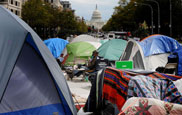 Olivier Douliery/Abaca Press/MCT
Olivier Douliery/Abaca Press/MCT
In contrast, many of the wealthy “1 percent,” made up of those who earn $343,927 per year or more, according to the latest IRS data, consider protesters hoodlums with nothing better to do than live communally in parks, behave promiscuously, do drugs, beat on drums, and wander around collecting handouts. They see the Wall Street encampment providing toiletries, Internet access, three meals a day, and free medical services, and wonder why those protesting should not have to work as they do to earn their keep. Some of them had to incur large debts, working long hours for little or no pay at the start of their careers, to become successful on Wall Street.
Plainly, this is a type of class warfare—a battle of the “haves” versus the “have-nots.”
Real Cost
Anger about the widening economic gap has led to unrest, placing a heavier burden on a floundering economy.
“The cost to already struggling municipalities, which must protect and clean up after the protesters, is soaring,” ABC News stated. “‘We know for a fact we’ve crossed the $300,000 threshold in terms of money spent so far for this operation,’ said Atlanta Mayor Kasim Reed.”
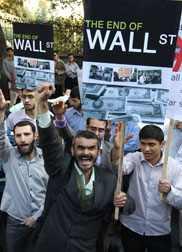 Atta Kenare/AFP/Getty Images
Atta Kenare/AFP/Getty Images
The article continues, “In San Francisco, the bill is more than $100,000…Across the country, the figures are growing. In New York City, overtime costs are $3.4 million. In Minneapolis, the sheriff’s department reports spending $200,000. And in Boston, the tally is $2 million and counting.”
Yet the cost to Wall Street’s “one percent” so far? Little or nothing. Tax money pays for any damages incurred, adding further insult to injury to the economy.
Since the start of the protests, thousands have been arrested, and several police injured. Many businesses have closed, relocated or laid off staff due to poor sales revenue.
Reports of internal harm among fellow “occupationistas,” as the protesters label themselves, such as sexual assaults inside tent cities, continue to be reported. As of this writing, several weeks into the protests, four people had died, one from a suspected drug overdose.
The need for police to focus on maintaining order at protest sites, as opposed to dealing with real crime across the city, has also caused violence to increase. New York Post reported that the “number of people shot surged 154 percent” in two weeks in New York City.
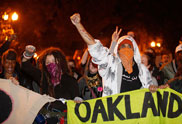 Kimihiro Hoshino/AFP/Getty Images
Kimihiro Hoshino/AFP/Getty Images
In Oakland, California, thousands of protesters determined to “halt capitalism’s flow” by shutting down the nation’s fifth busiest port. The city’s school district reported a $60,000 loss in personal day costs from teachers who joined the rally. Port authorities and local businesses were forced to end operations early and send home approximately 73,000 port employees.
Oakland’s City Administrator Deanna Santana reminded dissidents during a news conference that to maintain order “we need no fires, we need no vandalism, no throwing bottles, or rocks, or human waste at police officers. Police officers need to be allowed to enforce traffic…”
But the advice fell on deaf ears, and more violence occurred.
“Protests…were largely peaceful until around midnight local time…when some of the protesters reportedly lit a barricade on fire,” BBC News reported. “Afterwards, police fired tear gas and ‘flash bang’ grenades near the main plaza, where Occupy Wall Street protesters have been camping.”
YouTube videos of Oakland’s riots showed mobs of youth banging their heads on luxury cars passing through crowded streets, or dancing on top of tractor trailers trying to bypass blockades.
Are these the actions of “mature and responsible” adults?
Just days after California’s rampage, more violent protests erupted in Washington, D.C., in which a horde of demonstrators used children to blockade convention center exits so that attendees of a meeting they did not agree with would not be able to leave the building. In the melee, a 78-year-old woman was pushed down a flight of stairs and had to be taken to the hospital.
 Ralph Orlowski/Getty Images
Ralph Orlowski/Getty Images
European “occupy” participants have proved akin to their American counterparts.
“Clad in black with their faces covered, protesters threw rocks, bottles and incendiary devices at banks and Rome police in riot gear,” The Associated Press reported. “With clubs and hammers, they destroyed bank ATMs, set trash bins on fire and assaulted at least two news crews from Sky Italia. Riot police charged the protesters repeatedly, firing water cannons and tear gas. Around 70 people were injured, according to news reports, including one man who tried to stop the protesters from throwing bottles.”
Some argue that violent acts are perpetrated by a minority of the group. According to organizers, the movement is actively trying to maintain order and peace within their encampments.
“In less than four weeks, Occupy Wall Street managed to erect what looks and functions like a cross between a high-tech folk festival and a Canadian logging camp,” The Wall Street Journal stated. “At least for now, there’s a lending library on one end and a man doling out cigarettes on the other. There are stations for first aid, phone charging and poster-making. There’s even a guy who walks around handing out, yes, free money.”
How is it all funded? Dependence on others.
The article adds, “The whole operation runs on donations, of course. More than $5,000 in cash comes in every day through the park’s contribution boxes, and supplies flow in from around the country.”
How long can such a “leaderless” movement in which people of all ideologies—from anarchists to right-wing libertarians—who do not have a solid source of income other than donations really sustain itself?
Gaining Momentum
One striking aspect of occupy protests is the speed at which they have spread. Occupy Wall Street rapidly became Occupy Boston…Oakland…Tokyo…Berlin—all in a matter of weeks. This speaks volumes about the general mood across the United States and the world: people are discontented and yearning for solutions.
Middle- and lower-class citizens feel powerless. Many are jobless and hopelessly in debt. With the occupy protests, they at least feel they are “doing something” and “have a voice.”
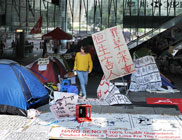 Laurent Fievet/AFP/Getty Images
Laurent Fievet/AFP/Getty Images
While the movement prides itself on being “leaderless” and “consensus-based,” how far can such a society really go? It may appear to work in a small-scale tent camp, but what would happen if it was applied to a metropolis of millions, an entire nation—or the world? Such a government would quickly become unwieldy and utterly unusable.
But consider: Is Occupy Wall Street really leaderless? Who is communicating with companies donating goods to the cause? Who decides how to distribute goods? And who ultimately decides what to post on the group’s “unofficial” website?
As history shows, there is inherent danger in a self-proclaimed “leaderless” group without a succinct purpose. The Economist wrote, “Populist anger, especially if it has no coherent agenda, can go anywhere in times of want. The 1930s provided the most terrifying example.”
Widespread discontent coupled with a leaderless mentality often gives rise to the worst kinds of leaders, ranging from WWII-era Germany to the numerous “presidents for life” ruling today.
Like it or not, those who are discontented always find a leader. History proves this. Human nature proves this. When someone stands up with a solid solution to bring back economic security and “the American Dream”—the vast majority will accept the new government, and its promised prosperity, with open arms. In the end, they want a government that can deliver the “good life.”
Occupy groups are providing this kind of life on a small scale now. Until recently, have you ever heard of a protest against “capitalist greed” where you can obtain gourmet organic meals, yoga mats, access to top-shelf computer products, and designer high-heel shoes?
OWS maintains that it desires to be sustainable and more “earth-friendly,” yet its actions prove those of the movement yearn to live a life of relative luxury—where smartphones, name-brand clothes, and high-speed Internet access are considered necessities. How much is this different from life in America now, where many of those below the poverty line lead lives of relative plenty?
According to a 2011 study by conservative think tank Heritage Foundation, among poor households, 80 percent have air conditioning—31 percent have two or more automobiles—almost two-thirds cable or satellite television—43 percent have Internet access—and one-third a wide-screen plasma or LCD TV.
Now think. What is life like for the 84 percent not in poverty?
Driving Force
While OWS has yet to come to a consensus on even one demand, there is an unstated core demand. The group blames the wealthy 1 percent, yet there have been billionaires for decades. Blame is also placed on mega corporations, while these have been around—and dodging taxes—for decades as well.
Ask: why were there not mass protests against the 1 percent in the 1980s or the 1990s?
The answer: few were concerned with greedy business practices when economic times were good and the rank-and-file were unaffected.
The unbridled desire to get more, whether power or money, is the real reason people are camped near Wall Street, in front of leading banks, and in cities across the world. But the protesters are not the only ones. This attitude runs deeper: everyone, from out-of-work single mothers drowning in bills to CEOs of Fortune 500 companies, is driven by some form of covetousness.
Until every person comes to this realization, there will never be true economic prosperity under a fair system. Admitting covetousness is a motivating factor would mean mankind would have to acknowledge that it does not have all the answers, and that no amount of philosophy or political theory can change that fact.
This would also mean seeking out often-overlooked sources of knowledge—especially those that can truly explain human nature. The best and most-ignored source for this sort of wisdom is the Bible. It explains what should be the operating assumption for trying to understand any economic problem.
The Old Testament book of Jeremiah hits the problem on the nose: “For from the least of them even unto the greatest of them every one is given to covetousness…” (6:13).
How true! Politicians covet their positions of power and promise the populace whatever their hearts desire, and citizens come to expect the government to provide for them—demanding more and more each time. It is a system that is doomed to fail as the prophet Jeremiah explains, “It is not in man that walks to direct his steps” (Jer. 10:23).
Just these two passages show manmade governments, no matter the ideals they are based upon, will fail. Why? Because they are based upon a desire to get.
Look at the lives of Americans and other prosperous nations of the West. Even those who are buried in unpaid student loans, are unemployed or underemployed, or have had to give up their cellphone and Internet access due to economic hardship, still have it better than the vast majority of the world.
If it is these conditions that can cause a supposed peaceful protest to turn wildly violent, what happens when grocery stores do not have food on the shelves? Or when the government stops paying Social Security or Medicare due to lack of funds?
The Bible also paints a picture of character breakdown in these times: “For men shall be lovers of their own selves, covetous, boasters, proud, blasphemers, disobedient to parents, unthankful, unholy, without natural affection, trucebreakers, false accusers, incontinent [unrestrained], fierce, despisers of those that are good” (II Tim. 3:2-3).
This is a startlingly accurate picture of today—and the world is only on the front edge of coming hard times! Yet fiscal mismanagement is just one factor in the current economic downturn. There are also weather upsets causing farmers to lose their crops, earthquakes destroying technology factories in Japan that push back the release of the latest gadget, and billions of dollars that could be spent on the economic recovery being sunk into national defense as a result of terrorism. The list could go on.
Modern trends are thoroughly explained throughout the Bible, which also details the only solution to these problems. It also reveals what sort of leader will spring forth from the economic climate that has birthed the Occupy Wall Street protests.
The Bible is often avoided because properly reading and understanding it can seem daunting. Yet it can be plainly understood, and help you make sense of the hard times—and beyond that, the very best time—ahead.
You do not have to be uncertain about your future!


